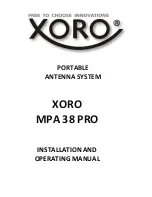
5
2.
Connect both ends of the supplied cable (common CAT-6 cable) to the motor assembly and controller.
3.
If possible, turn the receiver AGC off or set it to slow; bypass any external or automatic antenna tuner
and set the mode to CW (it has the lowest controller QRM noise).
4.
Note: Applies to HG-1 WR REMOTE LOOP TUNER.
The HG-1 WR
uses limit switches. So current sampling is not required to sense
the CW and CCW limits.
The red LED will stay on during capacitor
turning and turn off when reaching the CCW or CW limits, alerting
the operator to change tuning direction.
The makings on the
controller apply only to the HG-1 Remote Tuner Retrofit.
5.
Turn the HG-2 Remote Controller to SBY (on) and set the Rate
control to a mid-range setting.
6.
Using the red Up or green Down buttons, tune for a peak receive
signal (use your ears or the S meter). The maximum peak will be
brief, but obvious. You may have to momentarily push the Up or
Down buttons to get close.
7.
Once you receive an obvious peak signal, reduce the Rate control to about 1/3 and alternately make
small adjustments by briefly tapping the Up or Down buttons for the strongest peak signal.
8.
Note, when checking SWR, transmit a low power carrier. You should be able to achieve an SWR of 3:1 or
better. Once you achieve 3:1 or better, use an external or built-in auto tuner to touch up the SWR. You
should easily achieve an SWR of 1:1.5 or better.
9.
Set the receiver to the desired mode and turn the HG-2 Remote Controller off.
Differences Between Manual and Remote Tuning
When tuning manually the operator tunes for a peak receiver signal by rapidly turning a knob and listening for a
peak receive signal after which he then makes small adjustments to fine tune and to achieve the lowest SWR.
Because of AGC action, if you were to initially tune slowly, you might never notice the increased noise level
indicating a peak signal. Tuning with a remote controller is different. The operator sets the tuning rate and then
pushes either the up (red) or down (green) buttons to tune. Initially the tuning rate should be set fast to detect
a peak, after which the tuning rate is lowered to fine tune for best SWR. This takes a little practice at first. The
benefit is that your hand will not affect the tuning capacitor, and you can do this remotely without touching the
MLA itself.
(See
https://www.youtube.com/watch?v=aGlsGHuvUzI&feature=youtu.be























